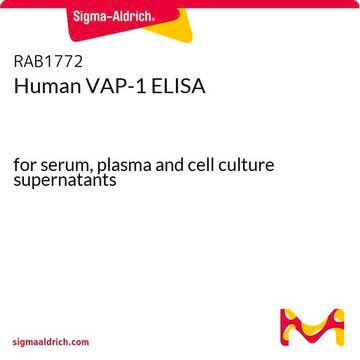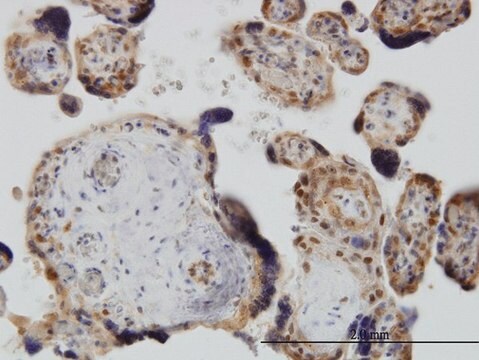SRP3295
VAP-1 human
recombinant, expressed in CHO cells, ≥95% (SDS-PAGE), ≥95% (HPLC)
Synonym(s):
AOC3, HPAO, SSAO
Sign Into View Organizational & Contract Pricing
All Photos(1)
About This Item
UNSPSC Code:
12352202
NACRES:
NA.32
Recommended Products
biological source
human
recombinant
expressed in CHO cells
Assay
≥95% (HPLC)
≥95% (SDS-PAGE)
form
lyophilized
mol wt
80.0-90.0 kDa
packaging
pkg of 10 μg
impurities
<0.1 EU/μg endotoxin, tested
color
white
UniProt accession no.
shipped in
wet ice
storage temp.
−20°C
Gene Information
human ... AOC3(8639)
General description
VAP-1 is a type II membrane cell adhesion protein belonging to the copper/topaquinone oxidase family. Recombinant VAP-1 is a mixture of monomeric and disulfide linked homodimeric forms of a 737 amino acid polypeptide corresponding to amino acids 27 to 763 of the VAP-1 precursor. The gene AOC3 (amine oxidase, copper containing 3) encodes a 170kDa homodimeric sialylated glycoprotein, VAP-1 (vascular adhesion protein-1), that is abundantly expressed in high endothelial venules (HEV) of peripheral lymph nodes. It is expressed in capillaries of non-lymphatic human tissues, such as kidney and heart. It is also expressed on on adipocytes, dendritic cells and smooth muscle cells.
Biochem/physiol Actions
The protein VAP-1 (vascular adhesion protein-1) belongs to the group of semicarbazide sensitive amine oxidases (SSAO) that catalyze the formation of reactive oxygen species. It is a unique adhesion molecule that participates in inflammatory leukocyte recruitment in blood vessels. It functions in leukocyte extravasation to inflamed tissues. In the human eye, it has been associated with ocular inflammatory diseases, such as uveitis, age-related macular degeneration, and diabetic retinopathy. Its expression has been observed to be altered in several diseases, such as rheumatoid arthritis, diabetes, and atherosclerosis.
Physical form
Lyophilized from 10 mM Sodium Phosphate, pH 7.8.
Reconstitution
Centrifuge the vial prior to opening. Reconstitute in water to a concentration of 0.1-1.0 mg/mL. Do not vortex. This solution can be stored at 2-8°C for up to 1 week. For extended storage, it is recommended to further dilute in a buffer containing a carrier protein (example 0.1% BSA) and store in working aliquots at -20°C to -80°C.
Storage Class Code
10 - Combustible liquids
WGK
WGK 3
Flash Point(F)
Not applicable
Flash Point(C)
Not applicable
Certificates of Analysis (COA)
Search for Certificates of Analysis (COA) by entering the products Lot/Batch Number. Lot and Batch Numbers can be found on a product’s label following the words ‘Lot’ or ‘Batch’.
Already Own This Product?
Find documentation for the products that you have recently purchased in the Document Library.
VAP-1-mediated M2 macrophage infiltration underlies IL-1?- but not VEGF-A-induced lymph- and angiogenesis.
Nakao S
The American Journal of Pathology, 178, 1913-1921 (2011)
A J Gearing et al.
Immunology today, 14(10), 506-512 (1993-10-01)
The demonstration of soluble isoforms of adhesion molecules has added a layer of complexity of our understanding of lymphoid-endothelial cell interactions. This is especially true in the light of observations which show levels of these isoforms to be raised during
Lama Almulki et al.
Experimental eye research, 90(1), 26-32 (2009-09-19)
Recently we showed a critical role for Vascular Adhesion Protein-1 (VAP-1) in rodents during acute ocular inflammation, angiogenesis, and diabetic retinal leukostasis. However, the expression of VAP-1 in the human eye is unknown. VAP-1 localization was therefore investigated by immunohistochemistry.
Our team of scientists has experience in all areas of research including Life Science, Material Science, Chemical Synthesis, Chromatography, Analytical and many others.
Contact Technical Service








